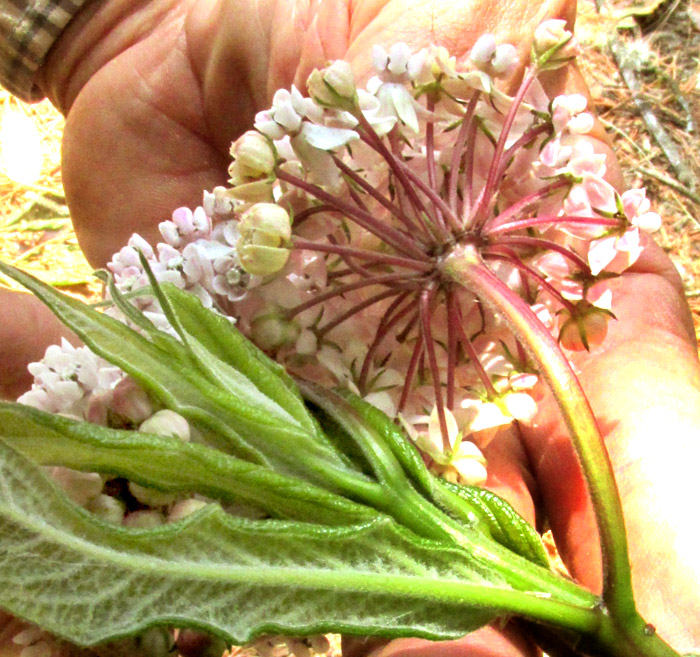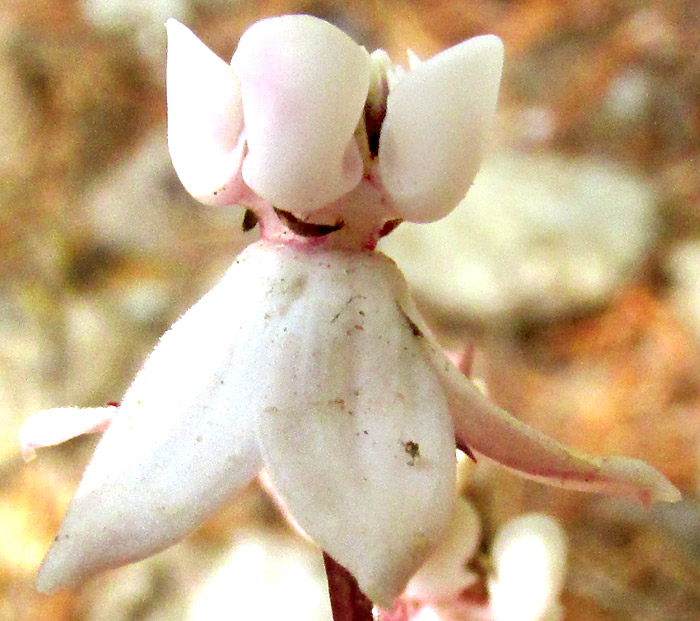Excerpts from Jim Conrad's
Naturalist Newsletter
Entry dated April 19, 2024, from notes taken about 1.5km northeast of Puerto de los Velazquez, Municipality of Pinal de Amoles; N21.138°, W99.665°, elevation ~2780 meters (~9120 feet); oak/pine forest on limestone bedrock; in the Eastern Sierra Madre Mountains of east-central Querétaro state, MÉXICO
MILKWEED WITH NO NAME

In a borderline cloud-forest atop a ridge, the wildflower shown above with two leaves at each stem node arising opposite one another, and clusters of crowded flowers gathered in pompom-like heads, was a classic milkweed, genus Asclepias, of the Dogbane or Oleander Family, the Apocynaceae. It caught my attention because I'd not seen the species anywhere else, but in this particular spot was abundant. Also, there was this:

The top of a plant, more brittle than I'd supposed, unfortunately snapped off as I maneuvered to photograph the curious feature: The uppermost cluster of flowers appears to arise from the stem's very top. Crowded, upward-directed, expanding leaves pushed into the head, and the leaves felt velvety and yielding.

Each flower stood atop a slender pedicel, and all the pedicels arose from the tip of a fairly long peduncle. This was normal for milkweed species.

Viewed from the side, not only a healthy earwig population was seen, but also that the blossoms' whiteness was lightly tinted in places with purple. At the flower's top, the five scoop-shaped hoods were broad and short, hardly or not at all extending above the flower's center part, the gynostegium. The trunk-like part where the earwigs gather is shorter than in many species.

From above, it's seen that the curving, fingerlike items, the horns, are unusually short and slender, not extending over the white disc in the center. The small, weak-looking, often crookedly arising horns are strikingly different from most milkweed horns.

At the right you can better see the horns' relative height to the hoods and gynostegium. Horns, hoods and other features of the corolla are shaped to manipulate pollinators, so the size, shape and orientation of these parts are important, and vary greatly from species to species. You can compare this plant's features with other milkweed species we've encountered.

Leaf blades were unusually thin, with veins on the upper surface somewhat sunken, creating wrinkles in the blade.

Leaf undersurfaces where moderately short-hairy, or puberulent, and the stems were thick, smooth and almost glossy.
The milkweeds of Querétaro state haven't been dealt with taxonomically. However, the 2021 study by Verónica Juárez-Jaimes and others entitled "Riqueza y distribución del género Asclepias (Apocynaceae: Asclepiadoideae) en México," reports that nine Asclepias species have been documented for the state. The milkweeds of Hidalgo state, whose border lies only about 30kms to the east of this location, also in the Eastern Sierra Madres, have been closely examined in the 2018 master's thesis by Christopher Ostwaldo Cervantes Meza, entitled "Sinopsis del Género Asclepias (Asclepiadoideae, Apocynaceae) de Hidalgo, México." That work provides extensive descriptions and excellent photos of details of each species.
In that work, our ridgetop species' features and illustrations matched -- and matched quite well -- just one taxon: what's labeled "Asclepias sp. nov." It's a taxon Christopher Ostwaldo Cervantes Meza recognized as occurring in various locations in Hidalgo state, but which no one yet has scientifically described and named. Our plant, as of 2018, simply had no name, and our student wasn't in a position to give it one.
I tried to contact Cervantes and received a reply that the student Cervantes no longer dealt with taxonomy, but that his "Asclepias sp. nov." is soon to be published. Meanwhile another population of the taxon in Querétaro state, besides our own, has been located. And that's where our plant's name stands at this writing.
As such, the literature is void of information about it. From what I've seen, the taxon's most striking feature is that it is fairly rare but when it does appear it can be abundant; the same was noted by the student Cervantes. Also, its weak, sometimes crookedly growing horns are unusual, and so is the manner by which its inflorescences can appear at the very tip of the stalk, with soft, raglike leaftips growing up into them.